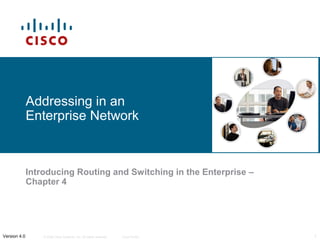Weitere ähnliche Inhalte
Ähnlich wie CCNA Discovery 3 - Chapter 4 (20)
Mehr von Irsandi Hasan (20)
CCNA Discovery 3 - Chapter 4
- 1. Addressing in an
Enterprise Network
Introducing Routing and Switching in the Enterprise –
Chapter 4
Version 4.0 © 2006 Cisco Systems, Inc. All rights reserved. Cisco Public 1
- 2. Objectives
Analyze the features and benefits of a hierarchical IP
addressing structure.
Plan and implement a VLSM IP addressing scheme.
Plan a network using classless routing and CIDR.
Configure and verify both static and dynamic NAT.
© 2006 Cisco Systems, Inc. All rights reserved. Cisco Public 2
- 3. Features & Benefits of a Hierarchical IP
Addressing Structure
Flat networks with a single broadcast domain lose
efficiency as hosts are added
Two solutions:
Create VLANs
Use routers in a hierarchical network design
© 2006 Cisco Systems, Inc. All rights reserved. Cisco Public 3
- 4. Features & Benefits of a Hierarchical IP
Addressing Structure
Classful network address in the Core Layer
Successively smaller subnets in the Distribution and
Access Layers
© 2006 Cisco Systems, Inc. All rights reserved. Cisco Public 4
- 5. Features & Benefits of a Hierarchical IP
Addressing Structure
Use subnetting to subdivide a network based on:
Physical location or logical grouping
Application and security requirements
Broadcast containment
Hierarchical network design
© 2006 Cisco Systems, Inc. All rights reserved. Cisco Public 5
- 6. Plan / Implement a VLSM Addressing Scheme
Subnet mask: 32-bit value
Distinguishes between network and host bits
Can vary in length to accommodate number of hosts on
LAN segment
© 2006 Cisco Systems, Inc. All rights reserved. Cisco Public 6
- 7. Plan / Implement a VLSM Addressing Scheme
Boolean ANDing compares bits in host address to bits
in subnet mask
1 and 1 = 1
1 or 0 and 0 = 0
Resulting value is network address
© 2006 Cisco Systems, Inc. All rights reserved. Cisco Public 7
- 8. Plan / Implement a VLSM Addressing Scheme
Steps in basic subnetting:
Borrow bits from the host side
Add them to the network side
Change mask to reflect additional bits
© 2006 Cisco Systems, Inc. All rights reserved. Cisco Public 8
- 9. Plan / Implement a VLSM Addressing Scheme
Elements of an addressing scheme:
Subnet number
Network address
Host range
Broadcast address
© 2006 Cisco Systems, Inc. All rights reserved. Cisco Public 9
- 10. Plan / Implement a VLSM Addressing Scheme
Benefits of Variable Length Subnet Masks (VLSM):
Flexibility
Efficient use of address space
Ability to use route summarization
© 2006 Cisco Systems, Inc. All rights reserved. Cisco Public 10
- 11. Plan / Implement a VLSM Addressing Scheme
Apply masks from largest group to smallest
Avoid assigning addresses that are already allocated
Allow for some growth in numbers of hosts on each
subnet
© 2006 Cisco Systems, Inc. All rights reserved. Cisco Public 11
- 12. Plan a Network Using Classless Routing
and CIDR
Classful routing Classless routing
Default subnet masks Network prefix
Class determined by first Slash (/) mask
octet
Subnet mask information
No subnet mask exchanged in routing
information exchanged in updates
routing updates
© 2006 Cisco Systems, Inc. All rights reserved. Cisco Public 12
- 13. Plan a Network Using Classless Routing
and CIDR
Classless Inter-Domain Routing (CIDR)
Uses address space efficiently
Used for network address aggregation or summarizing
© 2006 Cisco Systems, Inc. All rights reserved. Cisco Public 13
- 14. Plan a Network Using Classless Routing
and CIDR
Route summarization:
Use single address to represent group of contiguous
subnets
Occurs at network boundary
Smaller routing table, faster lookups
© 2006 Cisco Systems, Inc. All rights reserved. Cisco Public 14
- 15. Plan a Network Using Classless Routing
and CIDR
Discontiguous subnets cause unreliable routing
Avoid separating subnets with a different network
© 2006 Cisco Systems, Inc. All rights reserved. Cisco Public 15
- 16. Plan a Network Using Classless Routing
and CIDR
Use routing protocols that support VLSM
Plan subnetting to complement hierarchical design
Disable auto-summarization if necessary
Update router IOS
Allow for future growth
© 2006 Cisco Systems, Inc. All rights reserved. Cisco Public 16
- 17. Configure and Verify Static and Dynamic
NAT
RFC 1918: private IP address space
Routed internally, never on the Internet
“Hides” internal addresses from other networks
© 2006 Cisco Systems, Inc. All rights reserved. Cisco Public 17
- 18. Configure and Verify Static and Dynamic
NAT
Network Address Translation (NAT)
NAT translates internal private addresses into one or
more public addresses
Use on boundary routers
© 2006 Cisco Systems, Inc. All rights reserved. Cisco Public 18
- 19. Configure and Verify Static and Dynamic
NAT
Static NAT: map single inside local address to single
public address
Dynamic NAT: use a pool of public addresses to
assign as needed
© 2006 Cisco Systems, Inc. All rights reserved. Cisco Public 19
- 20. Configure and Verify Static and Dynamic
NAT
Port Address Translation (PAT)
Dynamically translate multiple inside local addresses to
one public address
© 2006 Cisco Systems, Inc. All rights reserved. Cisco Public 20
- 21. Summary
Hierarchical network design groups users into subnets
VLSM enables different masks for each subnet
VLSM requires classless routing protocols
CIDR network addresses are determined by prefix
length
Route summarization, route aggregation, or
supernetting, is done on a boundary router
NAT translates private addresses into public addresses
that route over the Internet
PAT translates multiple local addresses into a single
public address
© 2006 Cisco Systems, Inc. All rights reserved. Cisco Public 21
- 22. © 2006 Cisco Systems, Inc. All rights reserved. Cisco Public 22

